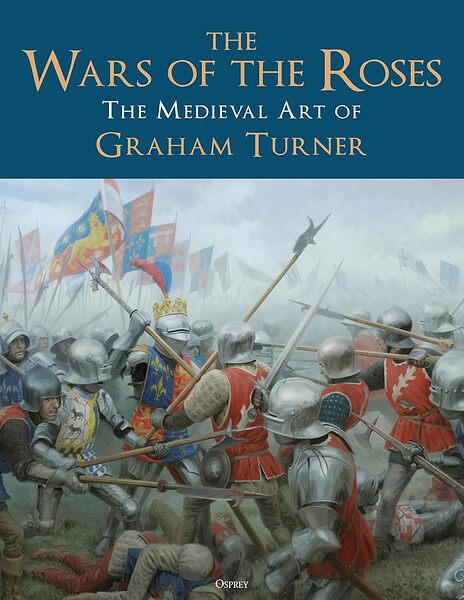Looking for a good read? Here is a recommendation. I have an unusual approach to reviewing books. I review books I feel merit a review. Each review is an opportunity to recommend a book. If I do not think a book is worth reading, I find another book to review. You do not have to agree with everything every author has written (I do not), but the fiction I review is entertaining (and often thought-provoking) and the non-fiction contain ideas worth reading.
Book Review
The Art of War in Medieval England
Reviewed by Mark Lardas
March 11, 2024
“The War of the Roses: The Medieval Art of Graham Turner,” by Graham Turner, Osprey Publishing, February, 2024, 288 pages $50.00 (Hardback), $35.00 (Ebook)
Graham Turner grew up fascinated by Arthurian legend. When he became a professional artist he expressed this boyhood interest into art, painting scenes illustrating Arthurian castles and knights errant. Arthurian legend first entered print around the era of the War of the Roses, leading Turner to study the armor and appearance of that era – and gain an equal fascination with that period.
“The War of the Roses: The Medieval Art of Graham Turner,” by Graham Turner, is the end result of that interest. It compiles forty years of his War of the Roses art in Turner’s history of the conflict.
The book is a comprehensive history of the war which ran from 1455 to 1487. It was a set of civil wars in England fought between two branches of the House of Plantagenet. A fratricidal conflict, it led to the demise of both competing Lancaster and York factions and their replacement by the House of Tudor. Fought during the transition from Medieval Times to the Modern Era it was either the last Medieval war or the first Modern one.
It felt profoundly medieval, with castles and armored knights. Turner allows readers to explore the era with him. He provides accounts of the battles fought, surrounding these with the background necessary to understand their context. He looks at the events leading up to conflict and the circumstances surrounding the war’s major events. This includes England’s relation with its neighbors and how they influenced the war. He examines the weapons, armor and tactics used. He looks at the society in which it was fought, where tournaments were often as significant as battles.
The text is enhanced by numerous illustrations. Many are Turner’s art; from simple pencil sketches to gorgeous full color paintings, often filling a page or spread over two pages. Eye-catching and scrupulously accurate, they are buttressed with modern color photographs of relevant places as they appear today and surviving artifacts (often taken by Turner), period illustrations and pertinent maps. Turner frequently pulls back the curtain on how he creates his art, showing the graphic sources he drew upon.
The artwork is such a significant part of the book it is best read in a print version. E-book editions, especially read on small e-readers in only black-and-white will likely leave readers unsatisfied. “The War of the Roses” is a magnificent book, one that deserves to be read in its full illustrated glory.
Mark Lardas, an engineer, freelance writer, historian, and model-maker, lives in League City. His website is marklardas.com.
